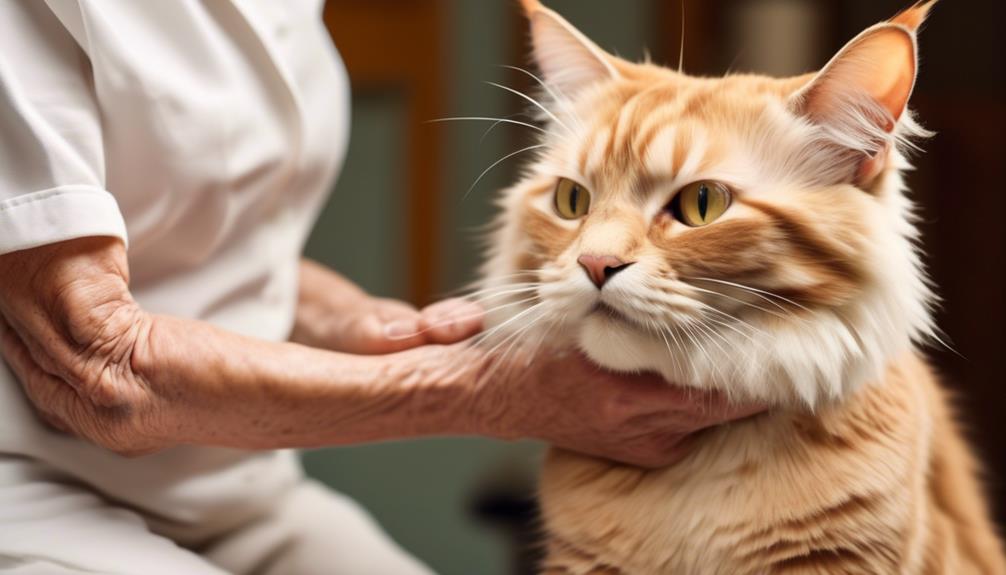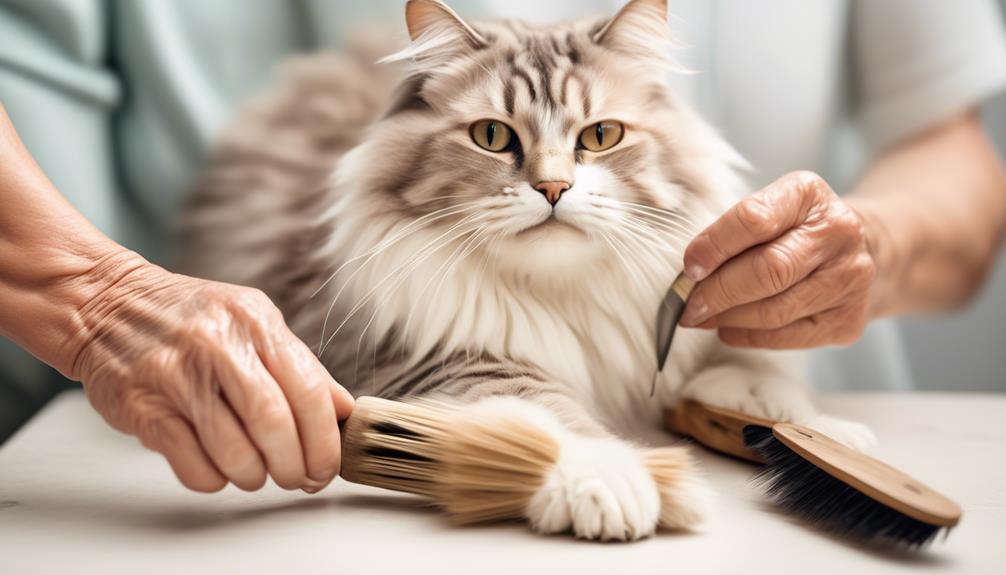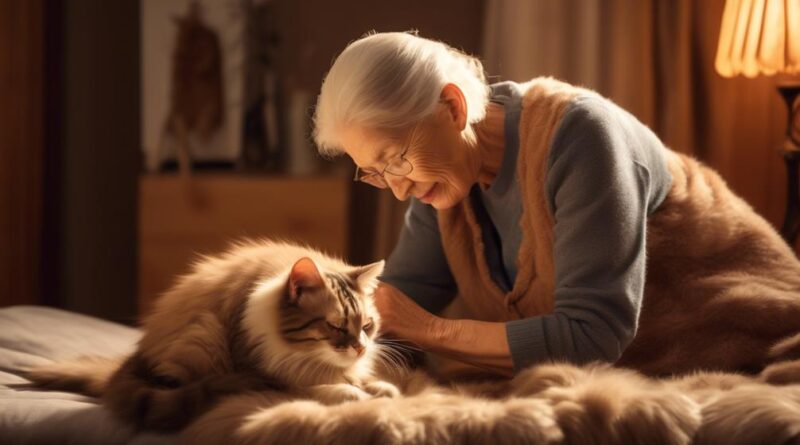Caring for Elderly Cats With Arthritis: Grooming Tips
You may have noticed that your elderly cat seems to be grooming less or struggling with it more. This is a common issue for cats with arthritis, and it's important to adjust your grooming routine to accommodate their needs.
In this discussion, we will explore practical tips for grooming your arthritic feline friend, from choosing the right tools to creating a comfortable environment for grooming. These tips will not only help maintain your cat's hygiene but also contribute to their overall comfort and well-being.
Understanding Arthritic Cat's Grooming Needs

If your elderly cat has arthritis, it's crucial to understand their specific grooming needs to ensure their comfort and well-being. Understanding feline arthritis is essential for managing feline arthritis symptoms effectively. Arthritis in cats can cause discomfort and stiffness, making grooming a challenging task for them. It's important to be gentle and patient when grooming your arthritic cat to minimize any pain or stress they may experience.
When understanding feline arthritis, it's vital to recognize the areas of your cat's body that may be particularly sensitive. Arthritic cats often have trouble reaching certain areas for grooming, such as their back or hind legs. As a result, these areas may become matted or dirty, leading to skin irritation or infection. To manage feline arthritis symptoms during grooming, consider using a soft brush with gentle strokes to help alleviate any discomfort.
Additionally, regular grooming sessions can help distribute natural oils throughout your cat's coat and improve circulation, which can provide some relief for their arthritic joints.
Understanding feline arthritis also involves adapting your grooming routine to accommodate your cat's limitations. For instance, if your cat has difficulty bending or twisting to groom themselves, you may need to trim their nails more frequently to prevent overgrowth and discomfort. Keeping your arthritic cat's fur trimmed, especially around their hindquarters, can also help them maintain hygiene and reduce the risk of skin issues.
Importance of Regular Grooming for Arthritic Cats
Understanding the specific grooming needs of your arthritic cat is crucial, and regular grooming plays a vital role in maintaining their comfort and well-being. As a responsible pet owner, you play a significant part in managing your cat's arthritis, and regular grooming is an essential aspect of their care routine. Here's why regular grooming is important for your arthritic cat:
- Pain Management: Arthritic cats often experience discomfort due to their condition. Regular grooming helps in managing their pain by keeping their coat clean and free from mats, which can cause additional discomfort. It also allows you to check for any skin irritations or lumps that may be bothering your cat.
- Improved Circulation: Grooming your arthritic cat regularly can help improve their circulation. Brushing their coat stimulates blood flow to the skin and helps distribute natural oils, promoting overall skin and coat health. This can be particularly beneficial for arthritic cats, as it contributes to their overall comfort and well-being.
- Monitoring Special Diets: Regular grooming provides an opportunity to monitor your arthritic cat's dietary needs. You can observe their appetite, check for any abnormalities in their feces, and ensure they're consuming their special diets properly, which is crucial for managing arthritis and overall health.
Choosing Gentle Grooming Tools for Arthritic Cats

When grooming an arthritic cat, it's essential to select gentle grooming tools that minimize discomfort and promote a soothing grooming experience. One important aspect to consider is handling your arthritic cat's paws gently. Arthritic cats can be particularly sensitive about having their paws touched, so it's crucial to use tools that are soft and non-invasive.
Look for grooming tools with soft, rounded edges that won't cause any unnecessary stress or discomfort to your cat's delicate paws. Additionally, using soft bristle brushes for sensitive skin is vital. Arthritic cats may have sensitive skin, and using harsh or stiff brushes can cause discomfort or even pain.
Instead, opt for brushes with soft, gentle bristles that will feel pleasant on your cat's skin while effectively removing loose fur and untangling any mats. These brushes are designed to provide a comfortable grooming experience while being gentle on your cat's sensitive skin.
Creating a Calm and Comfortable Grooming Environment
To create a calm and comfortable grooming environment for your arthritic cat, prioritize a quiet and soothing atmosphere that minimizes stress and discomfort. Creating a soothing grooming routine is essential for providing stress-free grooming experiences for your elderly cat. Here are some tips to help you achieve this:
- Choose a Quiet Location: Select a peaceful and familiar spot for grooming sessions. Minimize noise and distractions to help your cat feel relaxed and secure. Consider using a small, quiet room where you can focus on providing gentle care without interruptions.
- Use Soft Lighting: Gentle, natural lighting can help create a tranquil environment for grooming. Avoid harsh, bright lights that could startle or agitate your cat. Soft, diffused light can help set a calming mood for the grooming process.
- Play Soothing Music: Soft, calming music can help soothe your cat during grooming. Choose gentle, instrumental tunes or classical music to create a peaceful atmosphere. The soothing sounds can help your cat relax and feel more at ease during the grooming session.
Techniques for Brushing Arthritic Cat's Fur

Brushing your arthritic cat's fur requires gentle and deliberate movements to ensure comfort and minimize pain. When grooming your elderly cat with arthritis, it's essential to employ gentle brushing techniques to maintain your cat's comfort and joint care. Begin by using a soft-bristled brush to gently remove any loose fur. Ensure that the brush strokes are light and smooth, avoiding any vigorous or rough movements that could cause discomfort to your cat's sensitive joints.
Focus on areas where your cat may have difficulty grooming themselves, such as the lower back and hind legs. Use slow and steady motions, paying close attention to your cat's reactions to avoid causing any additional discomfort. Additionally, consider using a wide-toothed comb to gently work through any tangles or mats in your cat's fur. Be patient and avoid pulling or tugging at the fur, as this could lead to unnecessary stress and discomfort for your arthritic cat.
It's important to keep the grooming sessions brief and frequent to prevent the buildup of mats and tangles. Short, gentle grooming sessions will help maintain your cat's coat without causing excessive strain on their joints. Always be mindful of your cat's body language and responses during grooming, adjusting your techniques to ensure they remain comfortable throughout the process.
Trimming Arthritic Cat's Nails Safely
How can you safely trim an arthritic cat's nails to ensure their comfort and well-being?
Safeguarding joints and using the right nail care techniques are crucial for keeping your arthritic cat's nails trimmed without causing them any discomfort. Here are some essential tips to help you navigate this delicate task:
- Use the Right Tools: Invest in high-quality cat nail clippers specifically designed for the size of your cat's nails. Clippers with a sharp, precise cutting edge will minimize any crushing or splintering of the nail, ensuring a clean cut without causing additional stress on their joints.
- Be Gentle and Patient: When trimming your arthritic cat's nails, it's important to approach the process with patience and gentleness. Avoid rushing or applying excessive pressure, as this can lead to accidental nicks or cuts. Take breaks if your cat becomes agitated, and offer plenty of reassuring pets and treats throughout the process.
- Seek Professional Assistance if Needed: If you're uncertain about how to safely trim your arthritic cat's nails or if your cat is particularly sensitive, don't hesitate to seek assistance from a professional groomer or veterinarian. They can provide expert guidance and ensure that the nail trimming process is as comfortable as possible for your furry companion.
Handling Arthritic Cat's Sensitive Joints During Grooming

When grooming an elderly cat with arthritis, it's essential to handle their sensitive joints with care and caution, especially when addressing their nail trimming needs. Joint friendly grooming techniques are crucial to minimize discomfort for your arthritic feline.
Start by gently supporting the cat's leg and applying slight pressure to the joint to provide stability during the grooming process. Avoid sudden movements or excessive bending of the joints to prevent any pain or discomfort.
Using specialized grooming products can also make a significant difference in caring for an arthritic cat's sensitive joints. Look for nail clippers designed specifically for cats with arthritis. These clippers are often equipped with safety features that prevent over-cutting and provide better control, reducing the risk of accidental injury to the cat's delicate joints. Additionally, consider using a soft-bristled brush or comb to groom your cat's fur, as it's gentle on their skin and less likely to cause discomfort in their arthritic joints.
When handling your arthritic cat during grooming, always pay attention to their body language and vocal cues. If your cat shows signs of distress or discomfort, such as hissing, growling, or pulling away, take a break and allow them to rest. It's important to approach grooming sessions with patience and understanding, ensuring that your cat feels safe and comfortable throughout the process.
Maintaining Hygiene in Arthritic Cat's Skin and Coat
To maintain proper hygiene in your arthritic cat's skin and coat, gently wipe their fur with a damp cloth to remove any dirt or debris, keeping in mind their sensitivity to touch. Arthritic cats may struggle with grooming themselves effectively, so it's important to assist them in keeping their skin and coat clean and healthy.
Here are some tips to help you maintain your arthritic cat's hygiene:
- Regular Skin Massage: Gently massaging your cat's skin can help improve circulation and reduce stiffness in their joints. Use slow, circular motions to massage their skin, focusing on areas where they may have difficulty reaching due to arthritis. This can also help distribute natural oils and keep their skin moisturized.
- Use Soothing Shampoos: When bathing your arthritic cat, opt for soothing shampoos specifically formulated for sensitive skin. Look for shampoos that contain natural ingredients like oatmeal or aloe vera, which can help soothe any irritation or dryness while being gentle on their skin.
- Be Mindful of Water Temperature: When bathing your cat, ensure that the water temperature is comfortably warm. Extreme temperatures can be uncomfortable for arthritic cats, so it's important to use lukewarm water to avoid causing any additional stress or discomfort.
Frequently Asked Questions
Can I Use Human Arthritis Creams or Ointments on My Arthritic Cat's Joints to Help With Grooming Discomfort?
You shouldn't use human arthritis creams or ointments on your arthritic cat's joints. Instead, consider alternative treatments like massage therapy or natural remedies such as acupuncture therapy to help alleviate grooming discomfort for your cat.
Are There Any Specific Dietary Recommendations or Supplements That Can Help Improve My Arthritic Cat's Skin and Coat Health?
For improving your arthritic cat's skin and coat health, consider dietary recommendations and supplements. These can help with grooming discomfort and grooming signs. Additionally, bathing frequency and circulation improvement can aid in maintaining healthy skin and coat.
How Often Should I Bathe My Arthritic Cat, and Are There Any Special Considerations for Bathing a Cat With Arthritis?
You should bathe your arthritic cat as needed, focusing on gentle techniques to minimize joint pain. Regular grooming helps maintain skin health. Watch for pain signals and consider using mobility aids to make bathing easier for your furry friend.
What Are Some Signs That My Arthritic Cat Is Experiencing Grooming-Related Pain or Discomfort, and How Can I Address It?
If your arthritic cat shows signs of discomfort during grooming, try gentle brushing techniques and consider pain management options. Provide supportive grooming tools and make adjustments to help maintain skin health and mobility.
Are There Any Specific Grooming Techniques or Tools That Can Help Improve My Arthritic Cat's Circulation and Mobility?
To improve your arthritic cat's circulation and mobility, try gentle grooming techniques like soft brushing and massage. These can help increase blood flow and flexibility. Use a comb or brush designed for sensitive skin to avoid discomfort.
Conclusion
Now that you understand the grooming needs of your arthritic cat, you can provide them with the care and comfort they deserve. Remember to choose gentle grooming tools, create a calm environment, and use gentle techniques when grooming.
By keeping your cat's fur and nails well-maintained, you can help alleviate any discomfort they may be experiencing.
With your love and attention, your elderly cat can enjoy a happy and healthy life.
